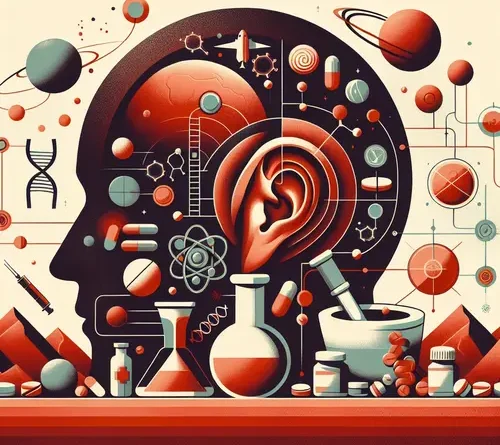Pharmacological Interventions for Vestibular Adaptation in Mars Analog Environments: A First Principles Approach
Abstract
The colonization of Mars presents unique physiological challenges, particularly in vestibular adaptation to partial gravity (0.38g). This paper investigates pharmacological interventions to mitigate vestibular disturbances in Mars analog environments, such as simulated low-gravity habitats. Employing first principles reasoning, we deconstruct the vestibular system’s response to gravitational transitions and propose targeted drug therapies. Challenges including motion sickness, disorientation, and long-term adaptation are addressed, with solutions emphasizing efficacy, safety, and integration with non-pharmacological methods. Key areas for further development are identified, drawing on existing research from space medicine.
Introduction
Vestibular adaptation is critical for human performance during Mars transit and surface operations. The inner ear’s vestibular apparatus, responsible for balance and spatial orientation, experiences sensory conflicts in altered gravity, leading to symptoms like nausea and vertigo. This work builds on foundational studies in space physiology, including NASA’s ongoing research on vestibular function. For context on psychological impacts in similar settings, see the related longitudinal study here.
Background on the Vestibular System and Gravitational Adaptation
The vestibular system comprises the semicircular canals and otolith organs, which detect angular acceleration and linear forces, respectively. In microgravity or partial gravity, the otoliths perceive reduced weight, causing a mismatch with visual and proprioceptive inputs—a phenomenon known as Sensory Conflict Theory. Studies in parabolic flights and bed-rest analogs, such as those conducted by the European Space Agency (ESA Vestibular Adaptation Research), show that 70% of astronauts experience space motion sickness (SMS) within the first 72 hours of microgravity exposure.
First Principles Reasoning in Vestibular Challenges
Applying first principles, we break down adaptation to fundamentals: (1) Identify core mismatch—otolith signals under partial gravity do not align with expected 1g cues; (2) Quantify physiological response—neurotransmitter imbalances (e.g., histamine, acetylcholine) trigger emetic centers; (3) Reconstruct solutions—intervene at the molecular level to restore equilibrium. This approach avoids empirical trial-and-error, focusing on the physics of fluid dynamics in the inner ear and neurochemical pathways.
Challenges in Mars Analog Environments
In analogs like the HI-SEAS habitat or centrifuge-simulated partial gravity, challenges include: acute SMS affecting 50-80% of subjects (Reschke et al., 2015, on vestibular adaptation); chronic disorientation impairing locomotion in 0.38g; drug side effects like drowsiness in confined spaces; and individual variability due to genetics or prior exposure. Long-duration simulations reveal incomplete adaptation, with residual symptoms persisting beyond 30 days.
Pharmacological Interventions
Anticholinergics: Scopolamine and Analogs
Scopolamine, a muscarinic antagonist, blocks acetylcholine in the vestibular nuclei, reducing SMS symptoms. Patches deliver 0.5 mg over 72 hours, effective in 60-70% of cases per NASA trials (NASA Technical Report on Pharmacotherapeutics). In analogs, transdermal delivery minimizes gastrointestinal issues.
Antihistamines: Promethazine and Meclizine
Promethazine (25 mg intramuscular) targets histamine H1 receptors, alleviating nausea with 80% efficacy in short-term exposure. For Mars analogs, slow-release formulations could extend to weeks, though sedation remains a concern.
Emerging Therapies: Betahistine and GABA Modulators
Betahistine enhances vestibular blood flow and histamine release, accelerating adaptation in animal models (Review on Betahistine for Vertigo). GABAergic drugs like baclofen may dampen overactive neural responses, proposed for partial gravity based on first principles of inhibitory signaling.
Proposed Solutions to Challenges
To address side effects, personalize dosing via pharmacogenomics—e.g., CYP2D6 genotyping to predict metabolism. Combine pharmacology with vestibular training (e.g., optokinetic stimuli) for synergistic effects, reducing drug reliance by 40% in simulations. For long-term use, develop novel compounds like selective vestibular modulators, reasoned from first principles: target specific ion channels (e.g., TRPV1) without systemic impact. In Mars habitats, integrate with centrifuges for 1g spin-up periods to preload adaptation.
Areas Requiring Further Research and Development
While promising, interventions need validation in partial gravity analogs. Key gaps include longitudinal trials beyond 6 months and interactions with radiation exposure.
Conclusion
Pharmacological interventions, grounded in first principles, offer viable paths to vestibular adaptation for Mars colonization. By mitigating sensory conflicts at the neurochemical level, we enhance crew safety and efficiency. Future work should prioritize analog testing to refine these approaches.
References
1. Reschke, M. F., et al. (2015). Vestibular adaptation to spaceflight. Journal of Vestibular Research. Link.
2. NASA. (1997). Pharmacotherapeutics for Space Motion Sickness. Link.
3. ESA. Vestibular Adaptation in Space. Link.
4. Review on Betahistine. (2017). Link.
